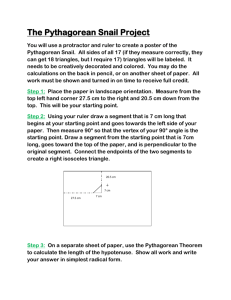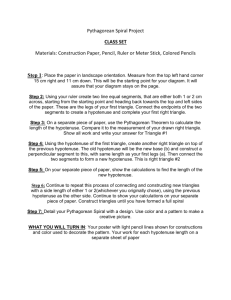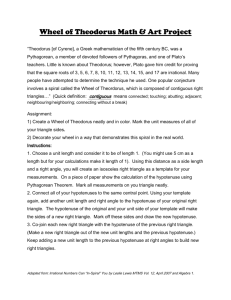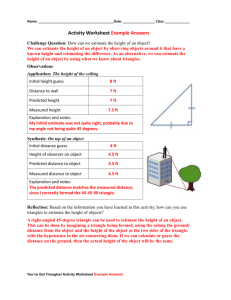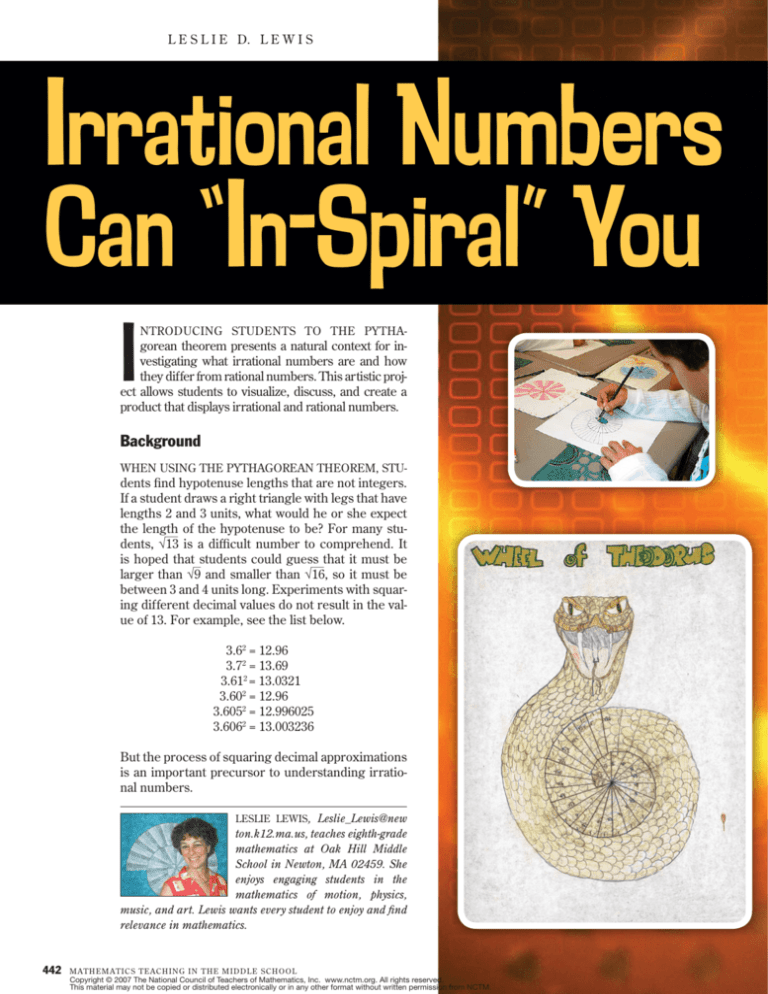
L e s l i e D. L e w i s
Irrational Numbers
Can “In-Spiral” You
I
ntroducing students to the Pytha­-
gorean theorem presents a natural context for investigating what irrational numbers are and how
they differ from rational numbers. This artistic project allows students to visualize, discuss, and create a
product that displays irrational and rational numbers.
Background
When using the Pythagorean theorem, stu-
dents find hypotenuse lengths that are not integers.
If a student draws a right triangle with legs that have
lengths 2 and 3 units, what would he or she expect
the length of the hypotenuse to be? For many students, 313 is a difficult number to comprehend. It
is hoped that students could guess that it must be
larger than 19 and smaller than 316, so it must be
between 3 and 4 units long. Experiments with squaring different decimal values do not result in the value of 13. For example, see the list below.
3.62 = 12.96
3.72 = 13.69
3.612 = 13.0321
3.602 = 12.96
3.6052 = 12.996025
3.6062 = 13.003236
But the process of squaring decimal approximations
is an important precursor to understanding irrational numbers.
Leslie Lewis, Leslie_Lewis@new
ton.k12.ma.us, teaches eighth-grade
mathematics at Oak Hill Middle
School in Newton, MA 02459. She
enjoys engaging students in the
mathematics of motion, physics,
music, and art. Lewis wants every student to enjoy and find
relevance in mathematics.
442
MATHEMATICS TEACHING IN THE MIDD LE SCHOOL
Copyright © 2007 The National Council of Teachers of Mathematics, Inc. www.nctm.org. All rights reserved.
This material may not be copied or distributed electronically or in any other format without written permission from NCTM.
Somebody in your class will probably type 313
into his or her calculator and declare that the square
root of 13 is 3.605551275. But square it, you say.
When 3.605551275 13
is squared on the calculator, 13
is shown. But is that accurate? Did the calculator
round up or down?13
Most calculators only display ten
digits. Is 3.605551275 only13an approximation of the
9
actual root? Square it manually.
Photographs by Marc A. Richmond; all rights reserved
9 2 = 12.999999996654125
(3.605551275)
9
16
Remind students that the numbers that they have
seen before either terminate (like 3.605) or have
a repetend (like 316
.605 ). These are called rational
numbers because they can16
be represented as a fraction with an integer
as the numerator and an integer
3.605
3605
3602
not equal to3zero
.605 =as the denominator.
and
3.605 = For.example,
3.605
13
1000
999
3605
3602
3.605 =
and 3.605 =
.
3605
3602
1000
999
3602
3
.
605
=
and
3
.
605
=
.
3.605 =
1000
999
999
9
That
3602
3.605 =
3602
999
32.605 =
999
16
2 topic for discussion. For now,
is another interesting
3
2
students can verify that 3602/999
is the repeating
3
.
605
decimal number
by manually dividing.
3
Having explored
4 = 2rational numbers briefly above, ex3
plain to students that 313 is called
an irrational number.
3605
3602
Its digits do 3not
in zeroes
.605
3.605or
= contain
. repeating
4terminate
==21000 and
9 = 3 be represented999
patterns, and it cannot
as a fraction of
4 =2
integers. Even though 313 and other irrational square
2
2
2 decimal numbers, they are
= 33602
roots cannot be9c written
as
3.605 == 1 + 1
9
= 3 in a drawing. If a right
easy to visualize 2and999
represent
c
=
2
triangle is drawn2 and2 the2 legs are carefully measured to
c = 1 +1
be 2 inches and c3 =inches,
the hypotenuse should
2 2 then
= 12 + 12
2 chypotenuse
c 2 = 2The
be 313 inches long.
could be measured
2
2 that the length is between
or the picture observed
c = 2 cto =see
4=
2),
3 and 4 inches.( To
the
c = 2of accuracy of a ruler, 313
3 degree
inches is now correctly represented (see fig. 1).
( 4 = 2),
( 4 = 2),
2 athtype
Class Activity4 =m
for figures
The fun now begins. To have students work
for figures
9m
= 3athtype
with this concept
in
13class, they are given a blank
mathtype
figuresOn the
piece of paper and a template
of aforsquare.
2
2
2
overhead projector
c = 13
1 I +draw
1 a right triangle, as shown
2
in figure 2a. The
process
is made easier by giving
2
13
c =2
students an accurate right angle. You could use the
2 2 card and mark off units on
corner of a 3 ×c5= index
3
the legs of the triangle. (See
2 fig. 2b.)
The class and I do the mathematics together. Us( 4 = 32),theorem, we calculate the length
ing the Pythagorean
2
3
of the hypotenuse of our isosceles
right triangle when
the length of each 2
leg is 1 unit.
4 =2
mathtype2for figures
4 =2
3
13 4 = 2
V O L . 1 2 , NO. 8 . a p r il 2 0 0 7
443
s
he
1
nc
3i
31
12
1
1
12
14
1
12
1
1 12
17
(a)
index card
1
(b)
index card
1
17
=
4 2
13
(b)
index card
Fig. 2 The (a) drawing is made on the overhead projector; (b)
shows that a 3 × 5 card can supply a good right triangle.
12
1
1
(c)
(b)
c2 = 12 + 12
c2 = 2
c = 12
The students can then see a visual representation
of 12 units and compare it with a length of 1 unit in
the drawing.
To find representations for more irrational lengths,
students can now use the calculations and drawing
that they have just completed. Using that 12 hypotenuse as one leg, they can draw another right triangle
with legs 1 and 12. Then, using the Pythagorean theorem, each student can calculate that this new hypotenuse must be 13 inches long. It is interesting to note
that the picture of 13 is so much easier to create than
the decimal approximation of 13 inches.
Continuing in this manner and building on the
images as shown in figures 3a–c, we can create
a graceful spiraling image known as the wheel of
MATHEMATICS TEACHING IN THE MIDD LE SCHOOL
1
1
16
(a)
1
1
1
(b)
1
15
1
1
11
17
1
1
1
4=2
11
13
15
12
2
14 = 1
1
1
Fig. 3 A spiral progression
1
15
1
16
1
1
12
(b)
1
1
(a)
13
1
16
1
112 4 = 2
1
(b)
12
12
1
1 =2
14
(a)
13
12
1
1
(a)
13
Fig. 1 Visualizing 313
1
1
1
=2
2 inches
1
13
(a)
2 inches
444
13
1
s
he
3 inches 3 inches
3 inches
nc
3i
31
s
he
nc
3i
31
2 inches
13
13
(c)
12
1
1
1
1
(c)
Fig. 4 A completed wheel of Theodorus, with and without color
Theodorus (see fig. 4). (Theodorus, a Greek mathematician of the fifth century BC, was a Pythagorean, a member of a group of devoted followers of
Pythagoras, and one of Plato’s teachers. Little is
known about Theodorus; however, Plato gave him
credit for proving that the square roots of 3, 5, 6, 7,
8, 10, 11, 12, 13, 14, 15, and 17 are irrational. Many
Photographs by Marc A. Richmond; all rights reserved
people have attempted to determine the technique
he used. One popular conjecture involves a spiral,
called the wheel of Theodorus, which is composed
of contiguous right triangles with hypotenuse
lengths equal to the square roots of 2, 3, and 4, up
to the square root of 17.)
Asking students to create this spiral by carefully
constructing a series of right triangles with one leg
remaining 1 unit long and the other leg being the
previous hypotenuse is an engaging class exercise.
At this point, the classwork ends. The project now
becomes an out-of-class task.
Students are given the assignment sheet and the
grading rubric shown in the appendix. In class,
I tell students that their grade will be determined
by meeting the criteria of the rubric. Students are
required to submit a colorful, labeled drawing with
an attached sheet showing their work for the first
eight triangles. They are free to create their images with as much or as little detail or artistry as
they choose.
Through the years, I have seen projects that are simple but colorful, mathematically correct and incorrect,
and delightfully intricate. I have received drawings of
sea shells, crustaceans, hair styles, and lollipops (see
the artwork featured throughout the article).
Asking students to label calculated side lengths
brings to the forefront their understanding of the
Pythagorean theorem. They also show their knowledge that some square roots are rational (14 = 2),
and some are not. They discover that irrational numbers are not very difficult to write in radical form or
to express in visual form.
Summary
Using art projects in my classes has great-
ly enriched the endeavor and joy of studying mathematics for me and for my students. Some of the
benefits are that students—
• gain a visual understanding of the mathematics
involved;
• complete the projects to the degree of patience,
artistic ability, and mathematical understanding
that they possess;
• who feel daunted by the abstractions of algebra can
often thrive using the techniques involved in the art;
• enjoy a break from the paper-and-pencil work
that is necessary in mastering mathematics;
• explain the relevance of their art to their families
and to the class; and
• who have not previously thrived in mathematics
class become leaders during this project.
Adding artistic applications to mathematics
classes, exploring the connections between music
and the Fibonacci sequence, or building intricate
and colorful models of polyhedra both motivate students and increase interest, conversation, pleasure,
and—most important—understanding.
My Web site, www2.newton.k12.ma.us/%7Eleslie_lewis/
polyhedra/index.htm, shows student work on three-dimensional figures they have made. This exploration helps students
become proficient with the intricacies of three-dimensional
space and translates wonderfully to network analysis.
Bibliography
Lewis, Leslie. “Polyhedra Creations by Oak Hill 8th
Graders.” www2.newton.k12.ma.us/%7Eleslie_lewis/
polyhedra/index.htm.
Newman, Rochelle, and Martha Boles. Universal Patterns.
Bradford, MA: Pythagorean Press, 1992.
Pappas, Theoni. The Joy of Mathematics, Discovering Mathematics All around You. San Carlos, CA: Wide World
Publishing/Tetra House, 1995.
Venters, Diana, and Elaine Krajenke Ellison. Mathematical Quilts, No Sewing Required. Berkeley, CA: Key Curriculum Press, 1999.
☞
V O L . 1 2 , NO. 8 . a p r il 2 0 0 7
445
Appendix
Wheel of Theodorus Art Project
Assignment
Create a wheel of Theodorus neatly
and in color. Mark the unit measures of all of your triangle sides.
Feel free to decorate your wheel
in a way that demonstrates this
spiral in the real world. Attach a
lined sheet of paper to your project
with your calcuations for the first 8
triangles.
Instructions
1.Using a template for a particular
unit length and a right angle, create an isosceles right triangle.
2.Using your template again, add
another unit length and right
angle to the hypotenuse of your
original right triangle.
3.Make a right triangle out of the
new unit lengths and the previous
hypotenuse.
446
4.Keep adding a new unit length
to the previous hypotenuse at
right angles to build new right
triangles.
5. When you get to the stage where
your right triangles will overlap
previous right triangles, draw
your hypotenuse toward the center of the spiral but do not mark
over the previous drawings.
6. Remember to label your figure
with all of the dimensions of your
successive right triangles. If a
hypotenuse has a length that is
a rational number, demonstrate
that you recognize this fact. (For
example, since 14 = 2, show this
on your project.)
Grading rubric
•Include a title for your picture.
•On the front of your picture,
MATHEMATICS TEACHING IN THE MIDD LE SCHOOL
include your signature and the
date.
• Label all triangle legs and hypotenuses with appropriate lengths.
•Conjoin each new right triangle
with the hypotenuse of the previous right triangle.
•Make sure your project is neat.
•Use color unless you mean to emphasize contrast by using black
and white.
• Write your labels using radicals
unless they can be simplified to rational numbers. For example, you
might label a hypotenuse 19 = 3.
•Connect all of your hypotenuses
to the same central point.
•Attach a lined sheet of paper to
your art containing your calculations to find lengths of segments
(using the Pythagorean theorem)
for your first 8 triangles. l

